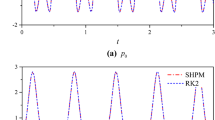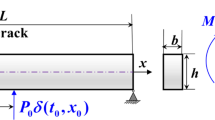Abstract
In this paper, the symplectic perturbation series methodology of the non-conservative linear Hamiltonian system is presented for the structural dynamic response with damping. Firstly, the linear Hamiltonian system is briefly introduced and its conservation law is proved based on the properties of the exterior products. Then the symplectic perturbation series methodology is proposed to deal with the non-conservative linear Hamiltonian system and its conservation law is further proved. The structural dynamic response problem with eternal load and damping is transformed as the non-conservative linear Hamiltonian system and the symplectic difference schemes for the non-conservative linear Hamiltonian system are established. The applicability and validity of the proposed method are demonstrated by three engineering examples. The results demonstrate that the presented methodology is better than the traditional Runge–Kutta algorithm in the prediction of long-time structural dynamic response under the same time step.













Similar content being viewed by others
References
Arnold, V.I.: Mathematical methods of classical mechanics. Adv. Math. 49, 106–106 (1983)
Du, C.F., Zhang, D.G., Li, L., et al.: A node-based smoothed point interpolation method for dynamic analysis of rotating flexible beams. Acta. Mech. Sin. 34, 409–420 (2018)
Marsden, J.E., Ratiu, T.S.: Introduction to Mechanics and Symmetry. Springer-Verlag, New York (1999)
Ghasabi, S.A., Arbabtafti, M., Shahgholi, M.: Forced oscillations and stability analysis of a nonlinear micro-rotating shaft incorporating a non-classical theory. Acta. Mech. Sin. 34, 970–982 (2018)
Wattanasakulpong, N., Chaikittiratana, A., Pornpeerakeat, S.: Chebyshev collocation approach for vibration analysis of functionally graded porous beams based on third-order shear deformation theory. Acta. Mech. Sin. 34, 1124–1135 (2018)
Li, W., Yang, X.D., Zhang, W., et al.: Free vibration analysis of a spinning piezoelectric beam with geometric nonlinearities. Acta. Mech. Sin. 35, 879–893 (2019)
Jin, M.S., Chen, W., Song, H.W., et al.: A frequency-domain method for solving linear time delay systems with constant coefficients. Acta. Mech. Sin. 34, 781–791 (2018)
Liu, C.S., Li, B.T.: An R(x)-orthonormal theory for the vibration performance of a non-smooth symmetric composite beam with complex interface. Acta. Mech. Sin. 35, 228–241 (2019)
Pan, Y.J., He, Y.S., Mikkola, A.: Accurate real-time truck simulation via semirecursive formulation and Adams-Bashforth-Moulton algorithm. Acta Mechanica Sinica, 641–652 (2019).
Wei, S., Chen, S.Q., Dong, X.J., et al.: Parametric identification of time-varying systems from free vibration using intrinsic chirp component decomposition. Acta. Mech. Sin. 36, 188–205 (2020)
Feng, K., Qin, M.Z.: Symplectic Geometric Algorithms for Hamiltonian Systems. Zhejiang Publishing United Group, Zhejiang Science and Technology Publishing House, Hangzhou and Springer-Verlag, Berlin Heidelberg (2010)
Feng, K., Wu, H.M., Qing, M.Z., et al.: Construction of canonical difference schemes for Hamiltonian formalism via generating functions. J. Comput. Math. 7, 71–96 (1989)
Sanzserna, J.M.: Runge-kutta schemes for Hamiltonian systems. BIT Numer. Math. 28, 877–883 (1988)
Tang, Y.F.: The symplecticity of multi-step methods. Comput. Math. Appl. 25, 83–90 (1993)
Bridges, T.J.: Multi-symplectic structures and wave propagation. Math. Proc. Cambridge Philos. Soc. 121, 147–190 (1997)
Reich, S.: Multi-Symplectic Runge-Kutta Collocation Methods for Hamiltonian Wave Equations. J. Comput. Phys. 157, 473–499 (2000)
Wu, Z., Zhang, S.: A Meshless Symplectic Algorithm for multi-variate Hamiltonian PDEs with Radial Basis Approximation Engineering Analysis with Boundary Elements 50, 258–264 (2015)
Sun, Z.J., Gao, W.W.: A meshless scheme for Hamiltonian partial differential equations with conservation properties. Appl. Numer. Math. 119, 115–125 (2017)
Qiu, Z.P., Jiang, N.: Comparative study of stochastic and interval non-homogeneous linear Hamiltonian systems and their applications. Chinese Journal of Theoretical and Applied Mechanics 52, 60–72 (2020)
Da Veiga, L.B., Lopez, L., Vacca, G.: Mimetic Finite Difference methods for Hamiltonian wave equations in 2D. Comput. Math. Appl. 74, 1123–1141 (2017)
Bao, S.Y.: A general solution of free vibration for rectangular thin plates in Hamilton systems. Journal of Dynamics & Control 3, 10–16 (2005)
Zhong, Y.: Analytic free vibration solution of fully clamped rectangular thin plate. Chinese J. Appl. Mech. 28, 323–307 (2011)
Qin, Y.Y., Deng, Z.C., Hu, W.P.: Multi-Symplectic Analysis of Vibration of Centrosymmetric Thin Circular Plate under Impact Load. Journal of Northwestern Polytechnical University 31, 931–934 (2013)
Yao, W.A., Sui, Y.F.: Symplectic solution system for Reissner plate bending. Appl. Math. Mech. 25, 178–185 (2004)
Bao, S.Y., Deng, Z.C.: Symplectic Solution Method for Mindin Middle Thich Plate. Acta Mech. Solida Sin. 26, 102–106 (2005)
Zhong, W.X., Yao, W.A., Zheng, C.L.: Analogy between Reissner plate bending and plane couple-stress. J. Dalian Univ. Tech. 42, 519–521 (2002)
Wang, Z.G., Tang, L.M.: Three-dimensional theory and Hamilton element method for analyzing composite Laminates. Acta Materiae Compositae Sinica 13, 111–117 (1996)
Xu, X.S., Jia, H.Z., Sun, F.M.: A method of symplectic eigensolutions in elastic transverse isotropy cylinders. J. Dalian Univ. Tech. 45, 617–624 (2005)
Zou, G.P.: Hamilton system and symplectic algorithms for the analysis of piezoelectric materials. Chinese Journal of Computation Physics 14, 735–739 (1997)
Zhu, W.Q.: Stationary solutions of stochastically excited dissipative Hamiltonian systems. Acta. Mech. Sin. 25, 666–684 (1993)
Zhu, W.Q., Huang, Z.L.: Stochastic Stability of Quasi-Hamiltonian Systems. Journal of Nonlinear Dynamics in Science and Technology 5, 148–153 (1998)
Wang, Y., Mei, F.X., Xiao, J., et al.: A kind of non-conservative Hamilton system solved by the Hamilton-Jacobi method. Acta Physica Sinica 66, 0545011–0545016 (2017)
Zhang, S.Y., Deng, Z.C.: Lie Group Integration Method for Dissipative Generalized Hamiltonian System with Constraints. International Journal of Nonlinear ences & Numerical Simulation 4, 373–378 (2003)
Gao, D.Y.: Complementarity, polarity and triality in non-smooth, non-convex and non-conservative Hamilton systems. Philosophical Transactions Mathematical Physical & Engineering ences 359, 2347–2367 (2001)
Qiu, Z.P., Elishakoff, I.: Antioptimization of structures with large uncertain-but-non-random parameters via interval analysis. Comput. Methods Appl. Mech. Eng. 152, 361–372 (1998)
Choi, Y.J., Lee, U.: An accelerated inverse perturbation method for structural damage identification. Ksme International Journal 17, 637–646 (2003)
Khodaparast, H.H., Mottershead, J.E., Friswell, M.I.: Perturbation methods for the estimation of parameter variability in stochastic model updating. Mech. Syst. Signal Process. 22, 1751–1773 (2008)
Sliva, G., Brezillon, A., Cadou, J.M., et al.: A study of the eigenvalue sensitivity by homotopy and perturbation methods. J. Comput. Appl. Math. 234, 2297–2302 (2010)
Qiu, Z.P., Qiu, H.C.: A direct-variance-analysis method for generalized stochastic eigenvalue problem based on matrix perturbation theory. SCIENCE CHINA Technol. Sci. 57, 1238–1248 (2014)
Qiu, Z.P., Zheng, Y.N.: Predicting fatigue crack growth evolution via perturbation series expansion method based on the generalized multinomial theorem. Theoret. Appl. Fract. Mech. 86, 361–369 (2016)
Wang, L., Liang, J.X., Yang, Y.W., et al.: Time-dependent Reliability Assessment of Fatigue Crack Growth Modeling Based on Perturbation Series Expansions and Interval Mathematics. Theoret. Appl. Fract. Mech. 95, 104–118 (2018)
Qian, Y.J., Yang, X.D., Wu, H., et al.: Gyroscopic modes decoupling method in parametric instability analysis of gyroscopic systems. Acta. Mech. Sin. 34, 963–969 (2018)
Acknowledgements
This work was supported by the National Nature Science Foundation of China (Grant 11772026), Defense Industrial Technology Development Program (Grants JCKY2017208B001 and JCKY2018601B001), Beijing Municipal Science and Technology Commission via project (Grant Z191100004619006), and Beijing Advanced Discipline Center for Unmanned Aircraft System.
Author information
Authors and Affiliations
Corresponding author
Additional information
Executive Editor: Jian Xu
Appendices
Appendix A: Conservation law of linear Hamiltonian System
The symplectic structure of the Hamiltonian system can be written as
where the notation “\(\wedge\)” denotes the exterior product. The matrix form of Eq. (A.1) is expressed as follows:
Considering \(\text{d}z_{j} \wedge \text{d}z_{k} = - \text{d}z_{k} \wedge \text{d}z_{j} ,(1 \le j \le n,n + 1 \le k \le 2n)\), Eq. (A.2) is equivalent to
Equation (A.3) can be rewritten as
Let
then the differentiation of \(\omega\) to \(t\) is
Based on the property of the differential form, Eq. (A.6) can be rewritten as
Considering the right multiplication of matrix \({\varvec{J}}\) only turns the position as well as the symbols of vector elements and the product of two negative unities make one positive unity, we can have
Substituting Eq. (A.8) into Eq. (A.7) yields
Considering \({\varvec{J}} \cdot {\varvec{J}} = - {\varvec{J}}^{ - 1} \cdot \user2{J = } - {\varvec{I}}\), we have
As \(\left( {{\varvec{J}}\text{d}{\varvec{z}}_{t} } \right)^{\text{T}} \wedge \left( { - \text{d}{\varvec{z}}} \right) = \left( {\text{d}{\varvec{z}}} \right)^{\text{T}} \wedge \left( {{\varvec{J}}\text{d}{\varvec{z}}_{t} } \right)\), Eq. (A.10) can be transformed as
For a linear Hamiltonian system, we can obtain
Let \(C = \left( {C_{jk} } \right)_{2n \times 2n}\), then Eq. (A.12) can be determined by
Considering \({\text{d}}z^{j} \wedge {\text{d}}z^{k} = 0 \,(j = k)\), Eq. (A.13) can be rewritten as
As \(C_{jk} = C_{kj} \,(k \ne j)\), we have
Substituting Eq. (A.15) into Eq. (A.14) yields
Consequently, the conservation law of the linear Hamiltonian system is proved.
Appendix B: Detailed proof about that a non-infinitesimal symplectic matrix can be approximately denoted by a linear combination of an infinite series of infinitesimal symplectic matrices
Firstly, we introduce a linear function, namely
where \({\varvec{B}}^{*}\) is an infinitesimal symplectic matrix while \(\Delta {\varvec{B}}\) is a non infinitesimal symplectic matrix. The parameters \(\alpha_{1} ,\beta_{1} ,\alpha_{2} ,\beta_{2}\) satisfy the following condition:
Hence, we can obtain
Based on the Taylor series expansion theorem, we can obtain
where \(f^{(k)} (0)\) represents the k-th derivative of function \(f\). Calculating \(f^{(k)} (0)\) yields:
By choosing a large value of parameter \(n\) we can obtain
Therefore, we can obtain
Substituting Eq. (B.7) into Eq. (B.4) yields
Consequently, a non-infinitesimal symplectic matrix is approximately denoted by a linear combination of an infinite series of infinitesimal symplectic matrices.
Appendix C: Conservation law of non-conservative linear Hamiltonian system
The symplectic structure of the non-conservative Hamiltonian system is expressed by
Expanding Eq. (C.1) yields
Expanding \(\omega\) as power series yields
Based on Eq. (C.2) and Eq. (C.3) we can have
The differentiation of \(\omega\) to \(t\) is expressed by
where
Let
then Eq. (C.6) can be transformed as follows:
For \(i = 0,\) it gives
As \({\varvec{z}}_{0}\) corresponds to a linear Hamiltonian system, its conservation law is proved in Sect. 2.2, namely
For \(i = 1,\) we can have
Substituting Eq. (18) into Eq. (C.11) yields
Simplifying Eq. (C.12) we can have
As \({\varvec{B}}_{0}\) and \({\varvec{B}}_{1}\) are infinitesimal symplectic matrices, we can have
Let \({\varvec{C}}^{0} = \left( {C_{jk}^{0} } \right)_{2n \times 2n} = {\varvec{JB}}_{0} ,{\varvec{C}}^{1} = \left( {C_{jk}^{1} } \right)_{2n \times 2n} = {\varvec{JB}}_{1}\), then \({\varvec{C}}^{0}\) and \({\varvec{C}}^{1}\) are symmetric matrices. Simplifying Eq. (C.13) yields
As \({\text{d}}z_{0}^{j} \wedge {\text{d}}z_{1}^{k} = - {\text{d}}z_{1}^{k} \wedge {\text{d}}z_{0}^{j}\) and \(C_{jk}^{0} = C_{kj}^{0}\) we can have
Based on Eq. (A.16) in Appendix A, we can obtain
Substituting Eqs. (C.16) and (C.17) into Eq. (C.15) yields
For \(i = l\), we can have
Simplifying Eq. (C.19) yields
Based on Eq. (C.16), we can similarly have
Substituting Eq. (C.21) into Eq. (C.20) yields
Based on Eq. (A.16) in Appendix A, we can similarly have
Therefore, we can have
Consequently, the conservation law of the non-conservative linear Hamiltonian system is proved.
Rights and permissions
About this article
Cite this article
Qiu, Z., Xia, H. Symplectic perturbation series methodology for non-conservative linear Hamiltonian system with damping. Acta Mech. Sin. 37, 983–996 (2021). https://doi.org/10.1007/s10409-021-01076-0
Received:
Accepted:
Published:
Issue Date:
DOI: https://doi.org/10.1007/s10409-021-01076-0




